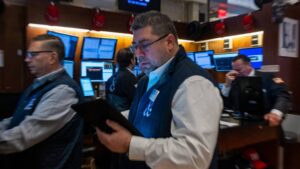The Rise of Leveraged and Inverse ETFs: A Deep Dive into Market Trends
Welcome to the Extreme Investor Network, where we equip you with the insights and analysis you need to navigate today’s dynamic trading landscape. One of the most significant trends currently affecting the stock market is the surge in trading volumes, particularly in leveraged and inverse Exchange-Traded Funds (ETFs). In this blog post, we will break down what’s driving this trend, who’s participating, and what it means for both novice and seasoned investors.
Understanding Leveraged and Inverse ETFs
Leveraged ETFs are designed to amplify the daily returns of a specific index or stock using financial derivatives. For instance, a 2x leveraged ETF would aim to return twice the percentage movement of its underlying index on a given day. Conversely, inverse ETFs are designed to deliver the opposite performance, ideally profiting when the market goes down.
Imagine this scenario: If the S&P 500 index rises by 1%, a 2x leveraged ETF should ideally show a return of 2%. However, if the market drops by 1%, a 2x inverse ETF would also reflect that movement, resulting in a 2% gain for that product. Both types have become particularly popular in a landscape characterized by heightened volatility and rapid market movements.
The Growing Popularity of Leveraged and Inverse ETFs
The ETF market has witnessed incredible growth over the years. The first leveraged and inverse ETFs entered the U.S. market in 2006, but fast forward to 2022, and we see a new wave: single-stock leveraged and inverse ETFs that have quickly captivated the retail market. Not only are assets in these products expanding rapidly, but they also constitute an increasing share of overall trading volume.
Key Players in the Space
As of late, major players like ProShares with their ProShares UltraPro QQQ (TQQQ)—offering 3x leveraged exposure to the Nasdaq 100—boast nearly $26 billion in assets. Other notable ETFs include:
- Direxion Daily Semiconductor Bull 3x (SOXL): $8.5 billion
- ProShares Ultra QQQ (QLD): $7.9 billion
- ProShares Ultra S&P 500 (SSO): $5.5 billion
According to Doug Yones, CEO of Direxion, about 75% of the ownership of these products lies in the hands of retail traders, with a burgeoning international interest that reflects a growing appetite for dynamic trading experiences.
Who is Driving This Trend?
Much of the increasing demand for leveraged and inverse ETFs is driven by a younger generation of investors who are more comfortable with digital trading platforms and the concept of leverage. As Todd Sohn, head of ETFs at Strategas, commented, “The barriers to entry are extremely low; you can buy these products on your phone.” In fact, 12%-15% of retail investors in these products hail from outside the U.S.—an indication of how global trading is becoming more interconnected.
Examining Daily Trading Volume
Interestingly, leveraged and inverse ETFs routinely appear among the most heavily traded ETFs on any given day. With the volatile nature of today’s market, these products allow traders to express short-term views, although they come with the caveat of daily resets. Let’s explore how daily performance can actually affect returns over time.
The Compounding Conundrum
Due to their structure, the returns on leveraged ETFs are not linear over multiple days. For example, let’s say the S&P 500 rises by 10% one day but then falls by 10% the next. A simple investment analysis reveals that you would have lost money if you had leveraged your investment:
| Day | ETF Type | Investment Value |
|---|---|---|
| 0 | Unleveraged Investment | $100 |
| 1 | Leveraged Up (20%) | $120 |
| 2 | Leveraged Down (20%) | $96 |
Instead of following the expected trajectory, the leveraged investment reflects a loss due to compounding effects. The lesson? These products are designed for traders looking for short-term gains and are not suitable for buy-and-hold investors.
Embracing the Risks
As the market continues to oscillate, understanding the inherent risks associated with these financial products is crucial. Doug Yones warns that, while leveraged and inverse ETFs may provide attractive short-term opportunities, retail investors should always assess risks, especially during periods of market downturns.
In conclusion, the growth of leveraged and inverse ETFs represents a broader trend in speculative trading that is reshaping the market. At Extreme Investor Network, we’re committed to providing you with the necessary insights to navigate these complexities safely and effectively.
Stay ahead of the curve, and equip yourself with the knowledge to capitalize on market trends while being mindful of the risks involved.
For more cutting-edge insights tailored specifically for you, don’t forget to subscribe to our newsletter or join our community!

